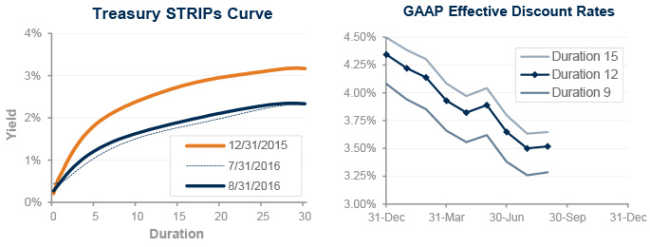August 2016 Pension Finance Update
August was an uneventful month for pension finance. Both model pension plans we track1 saw basically no change in pension funded status during the month. Through August, Plan A remains down 6% for the year, and the more conservative Plan B remains down 1%:

Assets
Stocks were up modestly in August: the S&P 500 was flat, but the NASDAQ added 1%, the small-cap Russell 2000 earned close to 2%, and the overseas EAFE index was up less than 1%. For the year, the S&P 500 is up more than 7%, the NASDAQ is up 4%, the Russell 2000 is up 10%, and the EAFE index is up 1% for 2016 through August.
A diversified stock portfolio gained less than 1% during August and is now up 6% through the first eight months of 2016.
Treasury rates rose almost 0.10% during August, producing losses of less than 1%, while corporate bond yields rose only a few basis points, producing flat returns for the month. For the year, bonds remain up 8%-11%, with longer duration bonds enjoying the best results.
Liabilities
Pension liabilities (for funding, accounting, and de-risking purposes) are now driven by market interest rates. The graph on the left compares Treasury STRIPs yields at December 31, 2015 and August 31, 2016, and also shows the movement in rates last month. The graph on the right shows our estimate of movements in effective GAAP discount rates for pension obligations of various duration during 2016:

Treasury yields inched up at most maturities during August, and corporate yields moved up even less. At the end of August, rates remain in all-time low territory, about 0.80% lower than at the end of 2015. Pension liabilities were unchanged on the month and remain 10%-15% higher than at the end of 2015, with long duration plans seeing the biggest increases.
Summary
2016 remains a decent year for pension assets, but the dominant theme remains all-time low interest rates and their effect on pension liabilities. At the end of August, interest rates are just a bit above all-time lows, producing pain for pension sponsors.
Rates could move lower still, but if we are near the bottom and rates move up in the months ahead, the headwind of pension liabilities could become a tailwind for plan sponsors.
The graphs below show the movement of assets and liabilities for our two model plans this year:

Looking Ahead
The Obama Administration and Congressional leaders passed a budget last fall that includes a third round of pension funding relief since 2012. The upshot is that pension funding requirements over the next several years will not be appreciably affected by current low interest rates (unless these rates persist). Required contributions for the next few years will be lower and more stable than under prior law.
Discount rates were basically unchanged last month. We expect most pension sponsors will use effective discount rates in the 3.2%-3.8% range to measure pension liabilities right now. These rates are as low as we’ve ever seen.
The table below summarizes rates that plan sponsors are required to use for IRS funding purposes for 2016, along with estimates for 2017. Pre-relief, both 24-month averages and December ‘spot’ rates, which are still required for some calculations, such as PBGC premiums, are also included.

1 Plan A is a traditional plan (duration 12 at 5.5%) with a 60/40 asset allocation, while Plan B is a cash balance plan (duration 9 at 5.5%) with a 20/80 allocation with a greater emphasis on corporate and long-duration bonds. For both plans, we assume the plan is 100% funded at the beginning of the year and ignore benefit accruals, contributions, and benefit payments in order to isolate the financial performance of plan assets versus liabilities.
